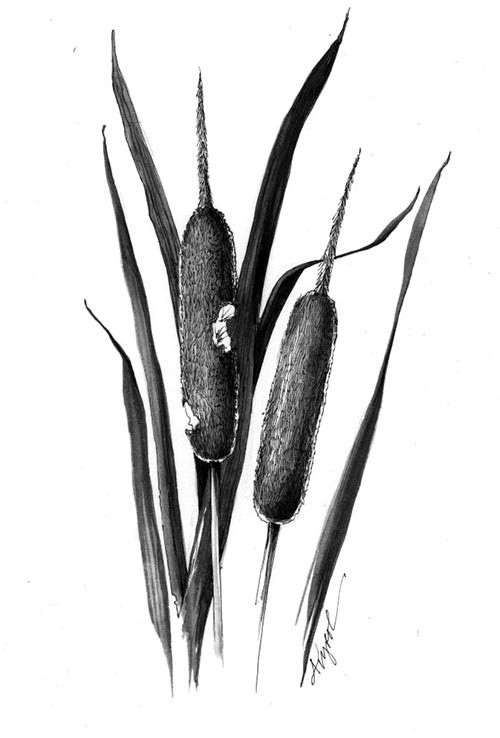
This past winter I spent three months exploring East Africa, traveling through ten different countries and covering over 8,077 miles. I was continuously impressed with how much local guides knew about their surroundings, in particular the human uses of various plants. In some instances we could not walk more than ten feet without stopping to learn about another plant and all the ways it could save your life.
This experience made me curious about plants in my own backyard. A quick skim of foraging articles on the Internet revealed that cattails, with their various edible parts, are often referred to as “nature’s supermarket.” I work at Seyon Lodge in Groton, Vermont, which is a stone’s throw from Noyes Pond. I was thrilled to learn that I had a 40-acre produce section right outside the back door.
My first attempt at harvesting cattails was inauspicious. Shovel in hand and wearing flip flops, I jumped into the pond – and discovered that flip flops were not the best footwear for moving around in deep mud. Digging up a cattail also proved more difficult than expected. I continued to hit rocks and thick mud with my shovel. I wrenched, pried, and finally – using all of my body leverage – released what I believed to be a cattail root system from the murky water. I hurried back to the lodge, took pictures of my trophy, and then rinsed it off for careful examination. It was the red tinge inside of the roots that made me stop from going any farther. I had read that, if one sees any color other than white inside the root, to not eat the plant. What I had pulled was yellow flag iris, which is toxic. With pond water squishing in my flip flops, I realized I needed to do more research before I started frying up foraged food.
So I began reading everything I could on cattails. The most common native cattail that grows in our region is the broad leaf, Typha latifolia. Cattails are a true survival food, as nearly all of the plant can be eaten and they are found almost everywhere in North America except the Arctic. Their pollen is high in protein and vitamin A and the roots are an excellent source of starch. The plants also have other traditional uses. There’s a record of the Chippewa tribe using the plant to make toys for their children. Cattail seed heads contain downy mounds, similar to the silk in milkweed pods. Some Native American cultures were reputed to use this material in diapers, to pack wounds, and also for bedding, clothing, and insulation.
Aside from their utility to humans, cattails play an important role in the food web, supporting many other organisms. Any sizable area of cattails is likely to host muskrats. If muskrats are around then one should also be on the lookout for their chief predator, the mink. I saw one of these small weasels in the cattails last fall. In the spring, insects that live in and on the cattails provide food for migratory birds. The plants also provide nesting habitat for many marsh birds, including red-winged blackbirds, swamp sparrows, and American bitterns.
By the time that I made my second harvest attempt, I was much better informed. I left the shovel and flip flops at the house. This time, I was after younger cattail stalks as well as the roots. Standing barefoot in ankle deep water, I pulled on a stalk, and easily detached it from its base. I slid my hand down a different stalk, submerging my arm into the water. I dug my fingers into the plant’s base in the mud, and with a tug, found myself holding a hairy, white root with the stalk still attached. Ten minutes later I had enough for a meal.
Back at the lodge, I peeled the long stalks, revealing a white, slightly firm inside. I trimmed the stalks in a similar way I would prepare asparagus. After rinsing and chopping, I threw them in a pan with some butter, salt, and pepper. They were delicious, with a texture similar to an onion.
For a separate meal, I tried out one of the roots. I cut it in half lengthwise, exposing the inner, white starchy part. I sauteed it, adding a splash of water at the end. After cooking I pulled away the dense, white insides hollowing out the root like a canoe. These strips were also very tasty.
I took a small amount of satisfaction in my accomplishment of not eating any poisonous plants. And my experience with cattails only deepened my admiration and respect for the East African guides. I am not sure if there is any better gift we can give each other than the motivation to better ourselves and seek knowledge.


Discussion *